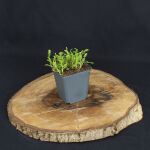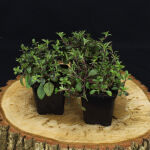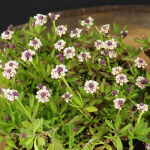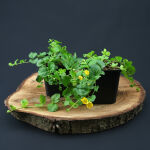alternative lawns
Alternative lawns offer far more variety in the garden.
Without decorative accessories, a large lawn looks boring. There are no flowers to brighten up the ambience. The green carpet also needs intensive care to keep the area attractive in the long term. It needs to be mown regularly, fertilised, scarified and watered during periods without rain. Shaded areas pose a further problem, as the stalks wither in the absence of sunlight. Various garden owners shy away from the effort and opt for alternative lawns. Or they prefer a flowering lawn from the outset.
How hardy is lawn substitute?
Basically, alternative lawns are classified as tread-resistant or walkable. Nevertheless, most plants are quickly overtaxed when subjected to heavy use. Therefore, careful planning and clarification is needed:
- Which areas will only be walked on occasionally?
- Where should the lawn alternative be more resistant because it will be walked on more often?
Lawn substitutes are nowhere near as hard-wearing as grass. Playing children and rampaging dogs will take their toll on the lawn alternative relatively quickly. If an area is continuously traversed, stepping stones are recommended to avoid unsightly trampling paths.
Flowering lawn advantages
Apart from being less labour-intensive, the alternative lawn contributes to greater biodiversity. Grasses are pollinated by the wind and do not need animal helpers. Short mowing intervals prevent the formation of spikes anyway. In contrast, perennials that cover a wide area adorn themselves with flowers. Their nectar attracts a host of insects. Butterflies, bees, bumblebees, beetles and hoverflies cavort on the flowering areas. Alternative lawns are generally frugal in terms of water requirements, as they protect the soil from drying out. Some species can survive the entire summer without additional watering.
Ground cover as a lawn substitute
Dense-growing cushions spread out and cover the ground without leaving any open spaces. They prevent erosion on slopes. Sprouting weeds have no chance under their compact growth. As flowering lawns they set colourful accents. Robust ground covers require almost no maintenance. With some you can even do without pruning. A mix of several varieties offers plenty of scope for creative garden ideas. Whether they are kept in a geometric design or planted wildly, it is the personal touch that decides the composition. Because there are sun worshippers and shade lovers among the lawn substitutes, there are plants for all places that thrive there.
Walk-on lawn substitute
Occasional steps are tolerated by the following plants (with details of the suitable location and maximum growth height), but high strains do them less good:
Cushion soapwort: sunny, 20 cm
Pennywort: sunny / semi-shady, 10 cm
Golden strawberry: semi-shade / shade, 20 cm
Prickly pear: sunny, 10 cm
Dwarf medlar: sunny / semi-shady, 15 cm
Alternative lawns with tread-resistant properties
This category of lawn substitute plants can withstand a little more stress. Examples:
Star moss: sunny / semi-shady, 10 cm
Creeping carpet verbena: sunny / semi-shady, 5 cm
Field sand thyme: sunny / semi-shady, 15 cm
Pinnate cushion: sunny / semi-shade, 5 cm
Thick-leaved male: shady, 25 cm
Partridge berry: sunny / shady, 10 cm
In which gardens does the lawn alternative fit?
Alternative lawns can be integrated into almost any outdoor area. Only where sports, games and social gatherings are the main focus does the classic alternative perform better. Shrubs such as abelia or mahonia planted between the lawn substitutes additionally loosen up the atmosphere and create further focal points.



















